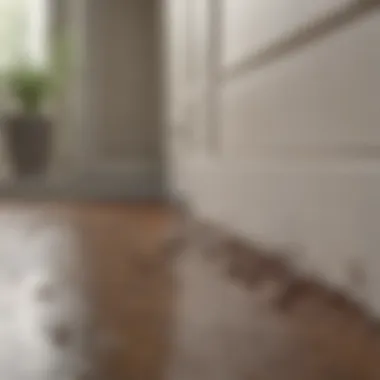Effective Strategies for Kitchen Ant Infestations


Intro
Ant infestations in kitchens present a widespread and persistent problem for homeowners. These small pests, driven by their quest for food and shelter, can quickly establish a presence that proves difficult to eradicate. This article aims to explore the nuances of ant behavior and identify effective strategies for prevention and management. Understanding these factors is essential in crafting a strategy that not only tackles existing infestations but also protects your kitchen from future occurrences.
Efficient management begins with identifying the specific species you are dealing with. Various types of ants, such as the common household ant, carpenter ant, and odorous house ant, exhibit different behaviors and nesting preferences. Each species requires a tailored approach for successful eradication and control.
The significance of maintaining cleanliness and organization in the kitchen cannot be overstated. Even the smallest crumbs or a slight residue left on surfaces can attract ants and provide a fertile ground for infestations. Through this article, we will delve into practical solutions and proactive measures for Indian, or any homeowner, to undertake in order to create an ant-free environment.
In the following sections, we will examine various strategies and solutions for managing ant infestations, focusing on prevention and effective eradication methods. This knowledge will empower readers to address this common issue with confidence and precision.
Understanding Ant Behavior
Understanding ant behavior is fundamental to effectively manage infestations in the kitchen. Ants are social insects with complex behaviors that impact their presence in the home. Knowledge of their habits, specifically how they find food, communicate, and establish colonies, is crucial. This understanding helps in developing targeted strategies for prevention and elimination, making it easier for homeowners to keep their kitchens ant-free.
Species Identification
Common kitchen ants
Common kitchen ants, such as Pheidole megacephala, Camponotus vagus, and Tapinoma sessile, play significant roles in infestations. Each species reflects distinct behaviors and advantages in regards to food sources and nest-building. Identifying these ants allows for effective remedy measures. For example, Pheidole megacephala has a large head and is often found in sugar-rich environments. This identification helps in targeting cleaning efforts in specific areas, limiting their food sources.
Behavioral traits of various species
Behavioral traits vary among ant species and understanding these differences can readily inform control efforts. Some ants, like Carpenter ants, are known to tunnel into wood, while others, such as Argentine ants, form expansive colonies that can shift locations rapidly. Identifying these traits aids in predicting their movements and trails, placing emphasis on potential eradication strategies. Each species might react differently to environmental changes, thus influencing control methods.
Importance of species identification in control strategies
Species identification is pivotal in determining appropriate control measures. Each ant species has unique vulnerabilities and preferred bait types. Knowing the species present informs choices such as types of traps or insecticides. Without proper identification, homeowners may waste time and resources chasing ineffective treatments. Targeted interventions ultimately lead to faster, more effective pest management.
Attraction Factors
Food sources
Food sources are a primary attraction factor for ants. Common foods include sugars, fats, and proteins, often found in open containers or spills. Keeping food tightly sealed and stored properly can significantly reduce attraction. If ants can access food quickly, they will remain persistent in their search. Detection of food sources helps in devising effective cleaning routines that inhibit ant attraction.
Moisture and humidity
Moisture and humidity create conducive environments for ants. Kitchens often have damp areas near sinks or leaks, making them particularly appealing. Reducing humidity through improved ventilation or addressing leaks can deter ants from frequenting. Monitoring the moisture levels in your kitchen helps in creating an unwelcome environment for potential infestations.
Nest locations
Nest locations are critical for understanding ant infestations. Ant nests may be found in wall voids, under appliances, or even in potted plants. Identifying these nests can provide insights into how much of an infestation exists. Seeking these locations allows homeowners to take proactive measures to eliminate nests and disrupt the colonies before they become a larger problem. Ant nests hidden close to indoors make eradication attempts more difficult, so early identification is key for effective control.
Initial Assessment of Kitchen Infestations
Understanding the initial assessment of kitchen infestations is crucial for effectively controlling ant populations. This step involves identifying how infestations arrive and prevail in the kitchen environment. By determining specific entry points for ants, one can strategize more effectively in preventing future invasions. Furthermore, assessing the situation accurately allows homeowners to allocate their resources wisely, either for DIY solutions or for seeking professional assistance.
Identifying Entry Points
Common entry locations
Ants are opportunistic creatures and often find their way into kitchens through several common locations. Cracks in walls, gaps around doors and windows, and openings around plumbing are prime entry points. These locations contribute to the overall topic of ant control as they serve as pathways for ants to invade and thrive. The ease of accessibility makes these entry points a significant concern during assessment. Knowing where these gaps are located permits targeted action, ultimately reducing the likelihood of further infestations.
Sealing potential access points
Sealing potential access points is a vital measure in preventing ants from entering the kitchen. Once entry points are identified, effective sealing becomes necessary. This may involve applying caulking to cracks and using weather stripping on doors and windows. The advantage of sealing is that it can drastically reduce the number of ants that can enter, effectively breaking their cycle of communication and feeding inside the home. Neglecting to seal these points could lead to recurring infestations, despite other control measures in place.
Inspecting the perimeter


Inspecting the perimeter of the kitchen and home is another integral part of initial assessment. A thorough inspection can reveal hidden nests or nearby colonies that may be close to the house. This important characteristic contributes to the overall assessment process because it encourages a broader understanding of ant behavior. Identifying nests allows for more targeted action, whether through baiting systems or by engaging pest control experts. However, this approach requires diligence and can be time-consuming depending on the size of the property.
Observing Ant Trails
How ants communicate
Ants communicate using pheromones, a specific aspect that plays a crucial role in how infestations can be managed. When one ant discovers food or a suitable nesting site, it releases pheromones that direct other ants to that location. Understanding this communication method helps in tracking the extent of the infestation. It is beneficial because it allows the homeowner to pinpoint heavy traffic areas, thus focusing eradication efforts more effectively. However, this communication can make infestations persistent if not addressed promptly.
Trail routes and patterns
Examining trail routes and patterns is key to understanding ant behavior. Ants establish pheromone trails which they follow repeatedly. Observing these trails can provide insight into where ants are coming from and going to, making this a valuable choice for this article. By mapping these routes, one can effectively set traps or apply baits in the most strategic locations to disrupt their routine. The disadvantage, however, lies in the potential difficulty of observing these patterns, especially if the infestation is extensive or if trails are not clearly visible.
Implications for control measures
Understanding the implications of ant trails for control measures is essential for effective management. Recognizing the locations of trails allows for tailored control strategies that can include bait placement and other treatment approaches. Targeting ant trails can lead to more successful eradication dates. However, this may require ongoing monitoring and adjustment as ant behavior changes in response to control measures. Not all methods are equally effective, hence adaptive strategies are important.
Preventive Measures for Ant Control
Preventing ant infestations in the kitchen is essential for maintaining a clean and safe living environment. By understanding and implementing preventive measures, you can significantly decrease the likelihood of an ant invasion. Many ants are attracted to the kitchen due to food availability and moist conditions, making it vital to address these factors proactively. Proper measures can save you from the trouble of dealing with an infestation later on.
Maintaining Kitchen Cleanliness
Importance of regular cleaning
Regular cleaning is a fundamental aspect of managing your kitchen environment. It helps to remove food residue and crumbs that can attract ants. The key characteristic of this practice is its simplicity and effectiveness. By incorporating daily cleaning rituals, you can significantly minimize the potential food sources available to ants.
A unique feature of regular cleaning is its preventive nature. Not only does it deter ants, but it also promotes overall hygiene. Neglecting this aspect can lead to various health issues due to unhygienic conditions. Therefore, regular cleaning stands out as a beneficial strategy in pest prevention.
Proper food storage techniques
Proper food storage techniques are crucial to preventing ants in the kitchen. This involves using airtight containers to store food items. The key characteristic of this practice is its ability to limit access to food, which is a primary attractant for ants. It is beneficial as it not only keeps your food fresh but also limits the chances of infestations.
One unique feature of proper food storage is its dual purpose: it protects food from pests while also maintaining a neat kitchen appearance. The disadvantages are minimal, mainly the initial cost of purchasing storage containers. However, the long-term benefits far outweigh this initial investment, making it a popular choice for homeowners.
Managing spills and crumbs
Managing spills and crumbs is another critical area to focus on. Food particles and liquids spilt on surfaces can easily draw ants into your kitchen. The key characteristic of this approach is its immediate impact; cleaning up promptly can greatly reduce the risk of attracting pests.
The unique feature of managing spills is the quick response it necessitates. It encourages you to remain attentive to your kitchen environment. While it may seem tedious, the advantage is obvious. The less food waste left unnoticed, the lower the chances of ants entering your kitchen.
Landscaping Considerations
Landscaping considerations play a significant role in preventing ants from accessing your kitchen. Examining how your garden is arranged can help in creating a boundary that deters ants before they even reach your doorstep.
Gardening practices that deter ants
Implementing specific gardening practices can effectively deter ants from approaching your home. For example, planting mint near entry points can repel ants. The key characteristic of this practice is its organic nature, using natural deterrents to keep pests at bay.
A unique feature of using gardens in this way is the beauty of aesthetics combined with functionality. The disadvantage may include limited effectiveness in severe infestations; however, it is still a popular preventative measure.
Distance from kitchen to garden
The distance between your kitchen and garden can influence ant presence. Keeping a manageable distance does not eliminate ants but can reduce their likelihood of entering your kitchen. The key aspect is that a physical barrier offers some level of prevention.
A unique feature here is that this distance can also serve as a space for preventive measures, such as installing barriers. The disadvantage is that not all homes can easily alter their landscape. However, this remains useful, especially for new constructions or gardens under development.
Avoiding nesting habitats near home
Lastly, avoiding nesting habitats near your home is essential in ant prevention. This involves clearing debris and vegetation that may serve as nesting grounds. The important characteristic here is fostering an inhospitable environment for ants.


One unique feature is its broader impact on overall pest management. By removing potential nests, you not only help with ants but may also deter other pests. The disadvantage includes the ongoing maintenance needed to ensure these areas remain clear, but the benefits include a reduced pest population in general.
Effective Eradication Techniques
Addressing ant infestations successfully requires thorough understanding of effective eradication methods. These techniques are crucial in not only removing visible ants but also in targeting the root of the problem: the nests. The choice of eradication method can vary based on the severity of the infestation, the type of ant involved, and the environment. By implementing these techniques, homeowners can regain control over their kitchens and prevent future infestations.
Natural Remedies
Essential oils
Natural solutions have gained popularity in ant control, with essential oils being one of the most discussed remedies. These oils, including peppermint and tea tree, possess properties that can repel ants effectively. One key characteristic of essential oils is their pleasant aroma, which is appealing to humans but can be intolerable to insects. This is what makes them a popular choice in households that prefer a more natural approach.
Using essential oils involves mixing a few drops with water and spraying around entry points where ants are active. Their unique feature lies in their capability to disrupt the ant's sense of smell, creating confusion in their trail. However, the effectiveness may vary; some oils only provide temporary relief and may need frequent reapplication.
Vinegar solutions
Vinegar is another effective natural remedy. Its acetic nature disrupts the pheromone trails that ants rely on for navigation. The effectiveness of vinegar solutions highlights its key characteristic: it’s not only a deterrent but also a cleaning agent that removes food residues. Vinegar solutions can be created easily by mixing equal parts of vinegar and water.
This method is beneficial as it is non-toxic and easily accessible. One unique feature of vinegar solutions is their ability to provide a quick method to deter ants while also cleaning the affected area. However, some homeowners may find that the smell of vinegar lingers longer than desired, which may not be preferable.
Homemade baits
Homemade baits are another popular solution for ant eradication. They typically consist of a mixture of sugar, water, and borax or baking soda. These ingredients attract ants while simultaneously acting as insecticide. The strength of homemade baits lies in their specific formulation that lures ants into consuming the bait, which they then bring back to the nest, impacting the colony.
Homemade baits are appreciated for being cost-effective and made from common household items. A notable feature is their adaptability; different recipes can be tailored based on what attracts the specific ant species in question. However, they can take time to show effectiveness, which does not offer immediate results but can be a sustainable solution over time.
Commercial Products
Overview of ant traps
Ant traps are commercially available products designed to catch and kill ants efficiently. They typically use attractants to lure ants into a confined space, where they cannot escape. The key characteristic of these traps is their ease of use and discreet placement options. Homeowners appreciate ant traps because they offer a low-maintenance solution, requiring minimal handling.
These traps can be set in a variety of locations, making them versatile for different kitchen layouts. The main advantage of using ant traps is their ability to reduce populations quickly. However, one disadvantage is that they may not address the entire colony if placed incorrectly, as only the ants that encounter the trap will be affected.
Comparative analysis of insecticides
When selecting insecticides, it is crucial to understand their specific formulations, effectiveness, and safety measures. In the comparative analysis of insecticides, one key consideration is the active ingredients. This affects their speed and method of action. Some insecticides act quickly, while others may take days to show noticeable results.
Homeowners find it beneficial to compare prices, safety for pets, and toxicity levels before deciding on the right product. Unique features may include the ability to tackle specific ant species or the inclusion of slow-acting formulas that allow for better colony control. However, reliance on chemical insecticides can lead to resistance over time, requiring rotation of products and methods.
Safe application methods
Application methods of ant eradication products are vital to ensure effectiveness while maintaining safety. Safe application methods include reading labels carefully, wearing protective gear, and applying products in areas inaccessible to children and pets.
A significant key characteristic of safe application techniques is their focus on minimizing exposure to harmful chemicals. The unique advantage is that these methods help maximize the effectiveness of the products while ensuring a healthier environment. Neglecting safe application can lead to unintended consequences, placing both users and their families at risk.
Long-Term Management Strategies
Effective management of ant infestations requires a long-term commitment to prevention and monitoring. This approach goes beyond temporary fixes or reactive measures. By implementing systematic strategies, homeowners can not only reduce existing ant populations but also establish an environment less conducive to future invasions. The benefits encompass maintaining a cleaner kitchen space, reducing reliance on chemical treatments, and developing a proactive stance toward pest control.
Monitoring and Inspection
Regular checks for infestations
Conducting regular checks for infestations is a vital strategy in managing ant problems. This practice involves frequent and thorough inspections of kitchen areas where ants are known to invade. The key characteristic of regular inspections is their ability to catch infestations early. This method is popular because it allows for timely interventions before colonies can establish.
A unique feature of these checks is the observation of ant behavior and trails, providing insight into the size and location of the infestation. The advantages of this regular monitoring include more effective control measures and reduced pest management costs. However, it requires discipline and consistency, which some may find challenging.
Documenting findings


Documenting findings from inspections plays a crucial role in understanding and addressing ant infestations. This aspect involves keeping records of ant sightings, locations, and any measures taken. The key characteristic of documentation is the creation of a reliable history of pest activity in the kitchen. This practice is beneficial as it helps track patterns and the effectiveness of strategies over time.
A unique feature of documenting is its potential to highlight recurring problems or changes in ant behavior. This contributes to improved strategies tailored to specific situations. The disadvantage can be the effort required for thorough documentation, yet the insights gained can significantly enhance pest management efforts.
Adapting strategies based on patterns
Adapting strategies based on observed patterns is essential in long-term ant management. This process involves analyzing data collected from inspections and documentation. The key characteristic of this approach is its flexibility, allowing homeowners to refine their pest control methods as new information becomes available. It is a popular choice due to its effectiveness in responding to changing ant behaviors.
A unique feature of adapting strategies is the responsiveness to environmental factors or seasonal changes that might affect ant activity. The advantages include a more targeted control effort and the ability to minimize pest-related problems before they escalate. However, it may also necessitate a willingness to change and reconsider established methods, which can be difficult for some.
Engaging Professional Pest Control
When to consider experts
Determining when to engage professional pest control services is a critical decision point for homeowners. This choice should be made based on the severity of the infestation, the types of ants involved, and the previous success of DIY methods. The key characteristic of involving experts is the specialized knowledge they offer regarding ant species and management strategies. This option is often beneficial for those facing persistent issues.
A unique aspect of consulting professionals is their access to commercial-grade treatments and techniques not available to the average homeowner. The advantages include a more thorough approach and peace of mind. However, the downside can be the associated costs, which may deter some homeowners from seeking this option.
Choosing the right pest control service
Choosing the right pest control service is essential for effective management of ant problems. This process should involve researching multiple companies, considering their experience, reputation, and treatment options. The key characteristic of this choice is ensuring alignment with the homeowner's specific needs. It is a beneficial step as the right service can provide tailored plans for ant control.
A unique feature in this consideration is the ability to ask for consultations or assessments before committing to a service. This facilitates informed decisions. The primary disadvantage can be the overwhelming number of options available, leading to potential confusion for homeowners in making the best choice.
Discussing integrated pest management options
Discussing integrated pest management options with professionals is a prudent approach to ant control. This strategy involves a combination of methods, including biological, cultural, and chemical practices. The key characteristic of integrated pest management is its holistic view of pest control, focusing on long-term prevention and environmental sustainability. This choice is often beneficial as it minimizes risks associated with chemical use.
A unique feature of this discussion is the collaborative approach between homeowners and pest control experts, allowing customization of solutions. The advantages include improved effectiveness and reduced impact on the environment and human health. On the other hand, it may require initial investments in training for sustainable practices, which some may find demanding.
"Taking a proactive stance through long-term strategies, including regular monitoring and expert consultation, can dramatically improve a household's ability to manage ant infestations successfully."
Engaging in long-term management strategies and considering professional help when necessary creates a comprehensive approach to addressing ant infestations in the kitchen.
Epilogue and Final Thoughts
In summary, understanding and addressing ant infestations in the kitchen is critical for maintaining a hygienic and safe environment. This article highlights several strategies to tackle this common problem, ranging from identifying ant behavior to implementing effective preventive measures. It is essential to recognize the vital role of cleanliness and the importance of a proactive approach to management. Monitoring and ongoing vigilance can help mitigate potential infestations before they escalate.
Summarizing Key Points
Recap of Ant Behavior Insights
Understanding ant behavior provides crucial context for managing infestations. Each ant species possesses distinct characteristics, influencing their attraction to certain sources. Recognizing these traits enables tailored control strategies. For example, knowing that sugar ants prefer sweet substances can guide food storage practices. This insight is beneficial because it lays the groundwork for anticipatory management, making it easier to take preemptive action before large infestations arise.
Reviewing Preventive and Remedial Measures
Preventive measures, such as maintaining cleanliness and sealing entry points, are fundamental to keeping kitchens ant-free. Revisiting these methods reinforces the necessity of consistent practices that protect against infestations. For instance, proper food storage techniques can thwart the access of ants to their primary food sources. This unique feature of preventive measures translates to lasting benefits, reducing the need for more extensive eradication efforts later.
Importance of Proactive Management
Equipping oneself with the tools for proactive management enhances the ability to respond to any signs of ant presence effectively. Timely interventions can prevent seemingly small issues from developing into full-blown infestations. Being proactive is a beneficial approach because it incorporates monitoring and adjustments into one’s routine. This unique characteristic ultimately fosters a healthier kitchen environment with less hassle.
Encouragement for Ongoing Vigilance
Responding to Potential Infestations
Prompt responses to signs of ant activity can greatly limit escalation. By addressing small sightings immediately, homeowners can prevent ants from establishing more complex trails. This characteristic makes it a beneficial choice in the overall strategy against infestations. Recognizing these early signs is essential; thus, vigilance plays a key role in ant management.
Adapting Strategies Over Time
As environmental conditions and household habits change, so should the strategies used to combat ant infestations. Flexibility in approach allows more effective solutions to emerge. An adaptive strategy signifies a commitment to continuous improvement, which is essential for successful pest management.
Continuously Improving Kitchen Maintenance
Regular maintenance and cleaning significantly contribute to a deterrent environment for ants. Establishing efficient cleaning routines not only minimizes food sources but also allows for the identification of potential access points early. The ongoing effort in kitchen upkeep reveals future vulnerabilities and promotes a less inviting atmosphere for pests. This continuous improvement will always pay dividends in both the short and long run.



